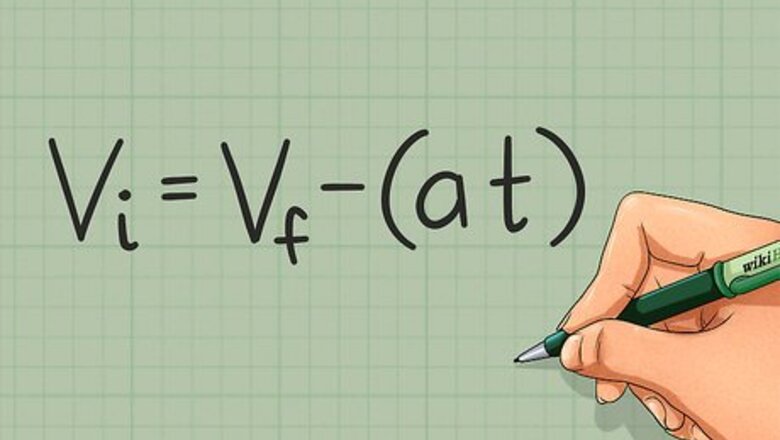
views
X
Research source
Often in physics problems, you will need to calculate the initial velocity (speed and direction) at which an object in question began to travel. There are multiple equations that can be used to determine initial velocity. Using the information given in a problem, you can determine the proper equation to use and easily answer your question.
Finding Initial Velocity with Final Velocity, Acceleration, and Time[2] X Research source
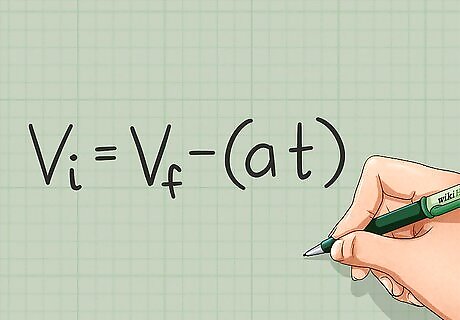
Know the right equation to use. In order to solve any physics problem you must know which equation to use. Writing down all of the known information is the first step to finding the right equation. If you have values for the final velocity, acceleration, and time involved, you can use the following equation: Initial velocity: Vi = Vf - (a * t) Understand what each symbol stands for. Vi stands for “initial velocity” Vf stands for “final velocity” a stands for “acceleration” t stands for “time” Note that this equation is the standard equation used when finding initial velocity.
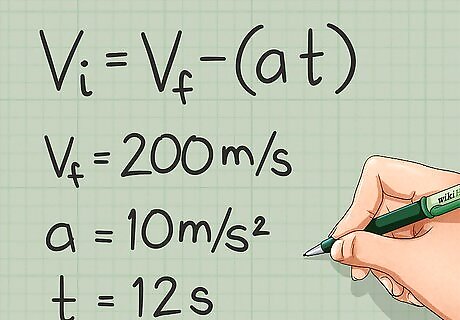
Fill in the known information. Once you have written the known information and determined the proper equation, you can fill in values for the appropriate variables. Carefully setting up each problem and writing out every step of the process is important. If you make a mistake, you can easily find it by looking back at all of your previous steps.

Solve the equation. With all of the numbers in place, use the proper order of operations to finish the problem. If you’re allowed, use a calculator to limit the number of simple math mistakes. For example: An object accelerating east at 10 meters (32.8 ft) per second squared traveled for 12 seconds reaching a final velocity of 200 meters (656.2 ft) per second. Find the initial velocity of that object. Write the known information: Vi = ?, Vf = 200 m/s, a = 10 m/s, t = 12 s Multiply the acceleration and time. a * t = 10 * 12 =120 Subtract the product from the final velocity. Vi = Vf – (a * t) = 200 – 120 = 80 Vi = 80 m/s east Write your answer correctly. Include a unit of measurement, usually meters per second or m/s, as well as a direction the object was traveling in. Without providing information about the direction, you only have a measurement of speed rather than velocity.
Finding Initial Velocity with Distance, Time, and Acceleration
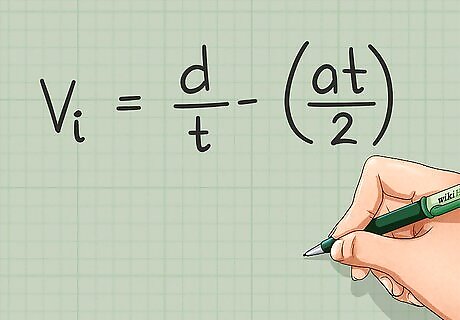
Know the right equation to use. In order to solve any physics problem you must know which equation to use. Writing down all of the known information is the first step to finding the right equation. If you know values for the distance, time, and acceleration, you can use the following equation: Initial velocity: Vi = (d / t) - [(a * t) / 2] Understand what each symbol stands for. Vi stands for “initial velocity” d stands for “distance” a stands for “acceleration” t stands for “time”

Fill in the known information. Once you have written the known information and determined the proper equation, you can fill in values for the appropriate variables. Carefully setting up each problem and writing out every step of the process is important. If you make a mistake, you can easily find it by looking back at all of your previous steps.
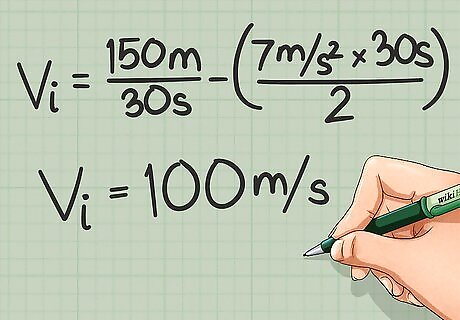
Solve the equation. With all of the numbers in place, use the proper order of operations to finish the problem. If you’re allowed, use a calculator to limit the number of simple math mistakes. For example: An object accelerating west at 7 meters (23.0 ft) per second squared traveled a distance of 150 meters (492.1 ft) within 30 seconds. Calculate the initial velocity of that object. Write the known information: Vi = ?, d = 150 m, a = 7 m/s, t = 30 s Multiply the acceleration and time. a * t = 7 * 30 = 210 Divide the product by two. (a * t) / 2 = 210 / 2 = 105 Divide the distance by the time. d / t = 150 / 30 = 5 Subtract your first quotient from the second quotient. Vi = (d / t) - [(a * t) / 2] = 5 – 105 = -100 Vi = -100 m/s west Write your answer correctly. Include a unit of measurement, usually meters per second or m/s, as well as a direction the object was traveling in. Without providing information about the direction, you only have a measurement of speed rather than velocity.
Finding Initial Velocity with Final Velocity, Acceleration, and Distance [6] X Research source
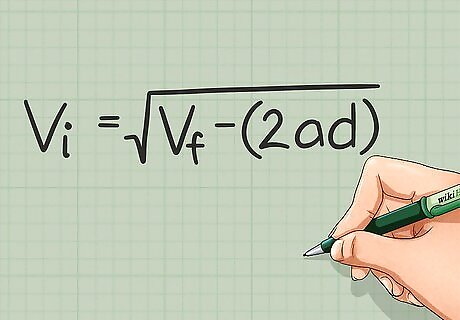
Know the right equation to use. In order to solve any physics problem you must know which equation to use. Writing down all of the known information is the first step to finding the right equation. If you are given the final velocity, acceleration, and distance, you can use the following equation: Initial velocity: Vi = √ [Vf - (2 * a * d)] Understand what each symbol stands for. Vi stands for “initial velocity” Vf stands for “final velocity” a stands for “acceleration” d stands for “distance”

Fill in the known information. Once you have written the known information and determined the proper equation, you can fill in values for the appropriate variables. Carefully setting up each problem and writing out every step of the process is important. If you make a mistake, you can easily find it by looking back at all of your previous steps.
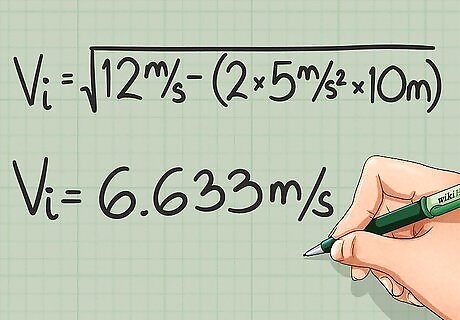
Solve the equation. With all of the numbers in place, use the proper order of operations to finish the problem. If you’re allowed, use a calculator to limit the number of simple math mistakes. For example: An object accelerating north at 5 meters (16.4 ft) per second squared traveled 10 meters (32.8 ft), ending up at a final velocity of 12 meters (39.4 ft) per second. Calculate the object's initial velocity. Write the known information: Vi = ?, Vf = 12 m/s, a = 5 m/s, d = 10 m Square the final velocity. Vf= 12 = 144 Multiply the acceleration by the distance and the number two. 2 * a * d = 2 * 5 * 10 = 100 Subtract this product from your previous one. Vf - (2 * a * d) = 144 – 100 = 44 Take the square root of your answer. = √ [Vf - (2 * a * d)] = √44 = 6.633 Vi = 6.633 m/s north Write your answer correctly. Include a unit of measurement, usually meters per second or m/s, as well as a direction the object was traveling in. Without providing information about the direction, you only have a measurement of speed rather than velocity.
Finding Initial Velocity with Final Velocity, Time, and Distance [8] X Research source

Know the right equation to use. In order to solve any physics problem you must know which equation to use. Writing down all of the known information is the first step to finding the right equation. If you are given the final velocity, time, and distance, you can use the following equation: Initial velocity: Vi = 2(d/t) - Vf Understand what each symbol stands for. Vi stands for “initial velocity” Vf stands for “final velocity” t stands for “time” d stands for “distance”
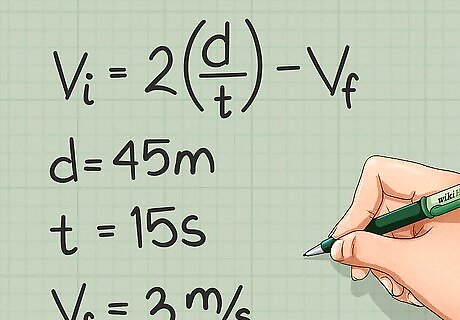
Fill in the known information. Once you have written the known information and determined the proper equation, you can fill in values for the appropriate variables. Carefully setting up each problem and writing out every step of the process is important. If you make a mistake, you can easily find it by looking back at all of your previous steps.
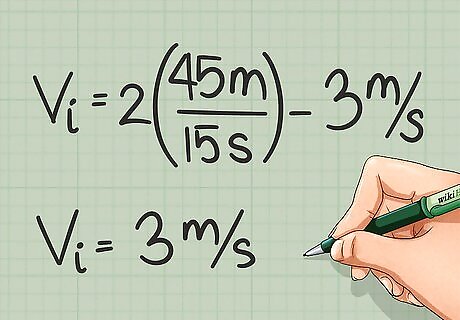
Solve the equation. With all of the numbers in place, use the proper order of operations to finish the problem. If you’re allowed, use a calculator to limit the number of simple math mistakes. For example: An object with a final velocity of 3 meters (9.8 ft) traveled south for 15 seconds and covered a distance of 45 meters (147.6 ft). Calculate the object's initial velocity. Write the known information: Vi = ?, Vf = 3 m/s, t = 15 s, d = 45 m Divide distance by time. (d/t) = (45/15) = 3 Multiply that value by 2. 2 (d/t) = 2 (45/15) = 6 Subtract final velocity from the product. 2(d/t) - Vf = 6 - 3 = 3 Vi = 3 m/s south Write your answer correctly. Include a unit of measurement, usually meters per second or m/s, as well as a direction the object was traveling in. Without providing information about the direction, you only have a measurement of speed rather than velocity.




















Comments
0 comment